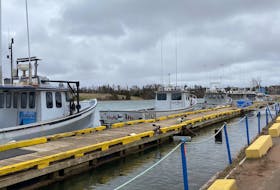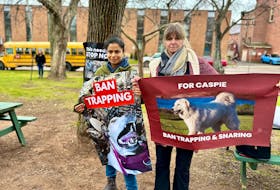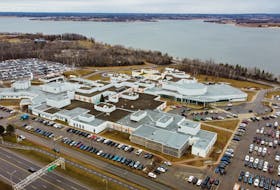For the past several weeks Charlton and his team have been busily preparing for the arrival of a large group of volunteers from all over Canada and the U.S. who will provide some muscle for the labour intensive project.
He’s all set for their arrival, he said, now he’s eager to get started.
“It’s pretty exciting,” he said, before pausing and admitting, “actually it’s a little bit stressful.”
Fortunately, Charlton has a lot of experienced help to call on for his project. He’s partnered with Jordan Cameron who built an Earthship in Wellington Centre two years ago. Click here to read about and see pictures of that project.
Both men are from Summerside and went to school together but didn’t connect until after they graduated and discovered they both had an interest in environmentally friendly construction. By that time, Cameron was deep into his Earthship project and Charlton ended up becoming one of his more ardent volunteers. Now that Charlton is building his own, Cameron was more than happy to return the favour.
“It’s going to be a fun time. I’m excited to be all helping hands and not have to use my brain too much or have the responsibility,” joked Cameron.
The term ‘Earthship’ is used to describe homes built using a method developed by Earthship Biotecture of Taos, New Mexico, in the early 1970s.
They use recycled junk as a primary building material like tires for walls, among other innovations.
They also use passive solar as a primary source of heat, hence big windows, with a small wood stove as backup. They also use solar power for electricity and catch and store rainwater for their primary water source. Washing water is filtered into an indoor greenhouse.
There will be a few differences between the Cameron’s home and Charlton’s, the latter is smaller: 800 square feet, versus 1,000 square feet. The Wellington Earthship required 600 tires, while the Hope River project will only need 500.
Charlton’s home will also be completely off the grid right from the start and will have a living roof, which uses vegetation and a waterproof membrane rather than tile or steel.
“It will look like a Hobbit hole,” said Charlton.
Despite the tweaks in the design, Cameron is confident that they learned enough from building his home that building Charlton’s will be a much smoother process.
“There’s going to be some challenges but … overall just because we’ve been through it before it’s going to be a lot more fun and easier,” he said.
The incoming volunteers will spend most of July pounding rows of tires full of earth to make up the walls of the structure. Then the two men and a few other helpers will finish the structure and living systems. They’re shooting to have the frame enclosed by September.
Once his home is finished, Charlton is planning to live almost entirely off the grid. Environmental sustainability is something he believes strongly in.
“The way things are going isn’t sustainable so something has to change,” he said.
“Instead of waiting for change from the top down, they should start doing it for themselves from the bottom up,” he said.
Anyone interested in following along as the Hope River Earthship is built, can do so through the Facebook group Cameron and Charlton originally set up for the Wellington Centre project, www.facebook.com/EarthshipPEI/.
They still have a couple of openings for volunteers and welcome used building materials and expertise. Anyone willing to provide any of these can contact them through Facebook or their website www.earthshippei.com.
@JournalPMacLean
For the past several weeks Charlton and his team have been busily preparing for the arrival of a large group of volunteers from all over Canada and the U.S. who will provide some muscle for the labour intensive project.
He’s all set for their arrival, he said, now he’s eager to get started.
“It’s pretty exciting,” he said, before pausing and admitting, “actually it’s a little bit stressful.”
Fortunately, Charlton has a lot of experienced help to call on for his project. He’s partnered with Jordan Cameron who built an Earthship in Wellington Centre two years ago. Click here to read about and see pictures of that project.
Both men are from Summerside and went to school together but didn’t connect until after they graduated and discovered they both had an interest in environmentally friendly construction. By that time, Cameron was deep into his Earthship project and Charlton ended up becoming one of his more ardent volunteers. Now that Charlton is building his own, Cameron was more than happy to return the favour.
“It’s going to be a fun time. I’m excited to be all helping hands and not have to use my brain too much or have the responsibility,” joked Cameron.
The term ‘Earthship’ is used to describe homes built using a method developed by Earthship Biotecture of Taos, New Mexico, in the early 1970s.
They use recycled junk as a primary building material like tires for walls, among other innovations.
They also use passive solar as a primary source of heat, hence big windows, with a small wood stove as backup. They also use solar power for electricity and catch and store rainwater for their primary water source. Washing water is filtered into an indoor greenhouse.
There will be a few differences between the Cameron’s home and Charlton’s, the latter is smaller: 800 square feet, versus 1,000 square feet. The Wellington Earthship required 600 tires, while the Hope River project will only need 500.
Charlton’s home will also be completely off the grid right from the start and will have a living roof, which uses vegetation and a waterproof membrane rather than tile or steel.
“It will look like a Hobbit hole,” said Charlton.
Despite the tweaks in the design, Cameron is confident that they learned enough from building his home that building Charlton’s will be a much smoother process.
“There’s going to be some challenges but … overall just because we’ve been through it before it’s going to be a lot more fun and easier,” he said.
The incoming volunteers will spend most of July pounding rows of tires full of earth to make up the walls of the structure. Then the two men and a few other helpers will finish the structure and living systems. They’re shooting to have the frame enclosed by September.
Once his home is finished, Charlton is planning to live almost entirely off the grid. Environmental sustainability is something he believes strongly in.
“The way things are going isn’t sustainable so something has to change,” he said.
“Instead of waiting for change from the top down, they should start doing it for themselves from the bottom up,” he said.
Anyone interested in following along as the Hope River Earthship is built, can do so through the Facebook group Cameron and Charlton originally set up for the Wellington Centre project, www.facebook.com/EarthshipPEI/.
They still have a couple of openings for volunteers and welcome used building materials and expertise. Anyone willing to provide any of these can contact them through Facebook or their website www.earthshippei.com.
@JournalPMacLean








